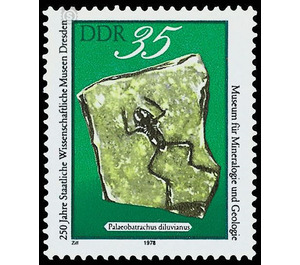250 years - Germany / German Democratic Republic 1978 - 35 Pfennig
| Country | Germany / German Democratic Republic |
| Issue Date | 1978 |
| Face Value | 35.00 |
| Color | green |
| Perforation | K 14 |
| Printing Type | Rotogravure 2 |
| Stamp Type | Postage stamp |
| Item Type | Stamp |
| Chronological Issue Number | 2115 |
| Chronological Chapter | GER-DDR |
| SID | 55025 |
| In 16 Wishlists | |
250 years of the Staatliche Wissenschaftliche Museen Dresden On the occasion of the 250th anniversary of the existence of the Staatliche Wissenschaftliche Museen Dresden, the Ministry of Posts and Telecommunications of the German Democratic Republic issues six multicolored special postage stamps. Special cancellations from October 24 to December 23, 1978 250th anniversary of the Staatliche Wissenschaftliche Museen Dresden In October 1978, the three Dresden Science Museums - The State Museum of Animal Science (10 and 20 Pfennig value), the State Museum of Mineralogy and Geology ( 25- and 35-pfennig value) and the State Mathematical-Physical Salon (40- and 50-pfennig value) its 250th anniversary. For this reason, these six special postage stamps appear with representations of rare exhibits from the individual collections of these museums. With the dissolution of the Electoral Saxon Kunstkammer in 1728, these museums became independent; It was only after the division of the extensive, very diverse holdings that the arbitrary and unscientific accumulated collections of representations of the private feudal rarity chamber gradually developed into public, scientifically directed and also evaluated collections. These museums, which have been research centers for years, are today among the most famous and well-known museums in the world within their scientific disciplines. The 35-pfennig value shows the incarcerated impression of a frog furrow - Palaeobatrachus diluvianus (GOLDFUSS) - from the polished slate of Seifhennersdorf / OL (Middle Oligocene). It is one of the best preserved and most rare animal fossils from the Tertiary (brown coal age) of the GDR. The paleobatrachides, extinct frogs, are very similar to the subspecies of the frog rut, the primitive tongue-less (Aglossa), which is today restricted in the tropical regions of Africa and South America. In the Tertiary of the southern GDR and in the north of the Czechoslovakia, these extinct frogs were found isolated in freshwater deposits of brown coal time. The Seifhennersdorfer Fossil was found in 1956 on the dump of the former polished slate mine.


